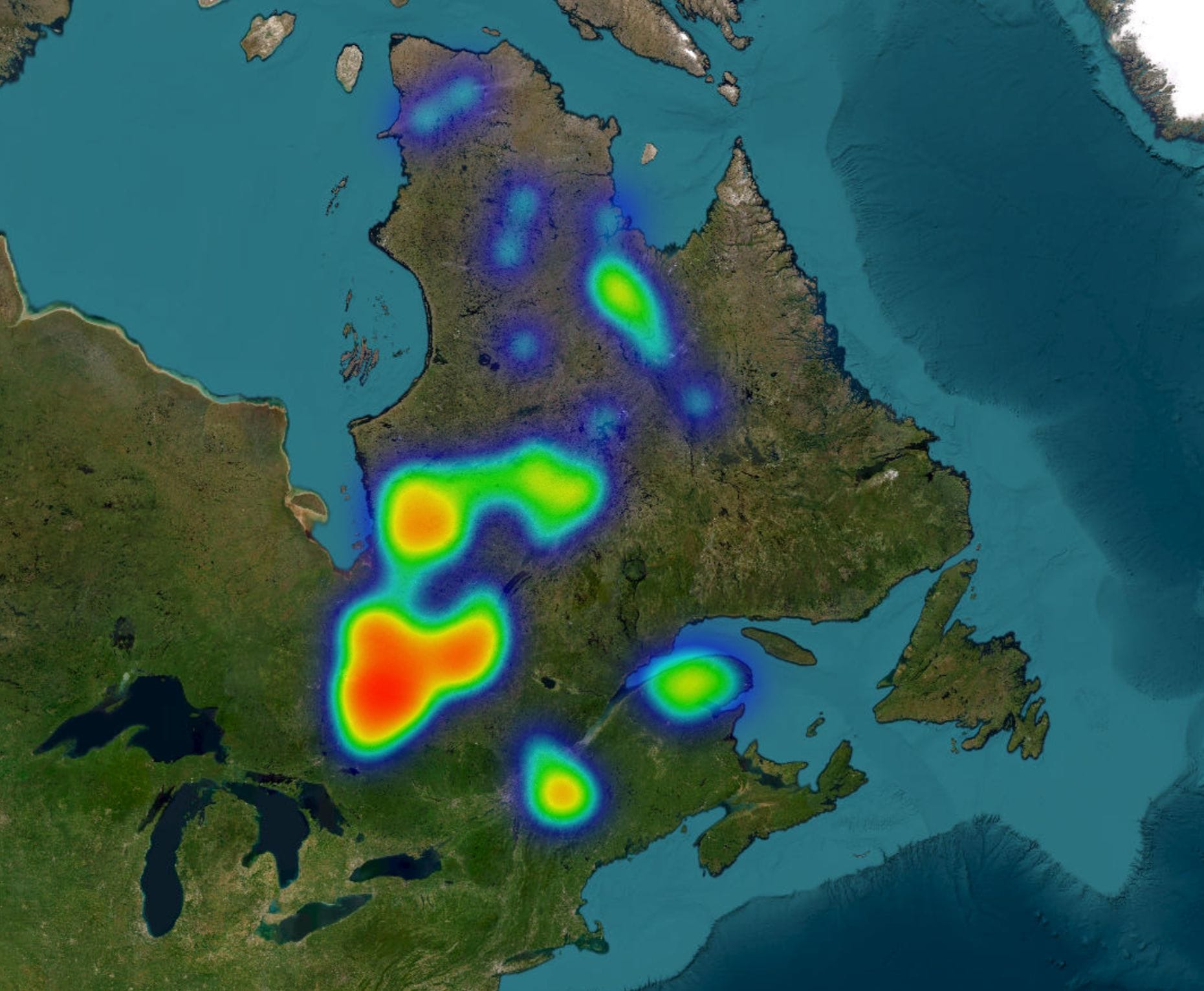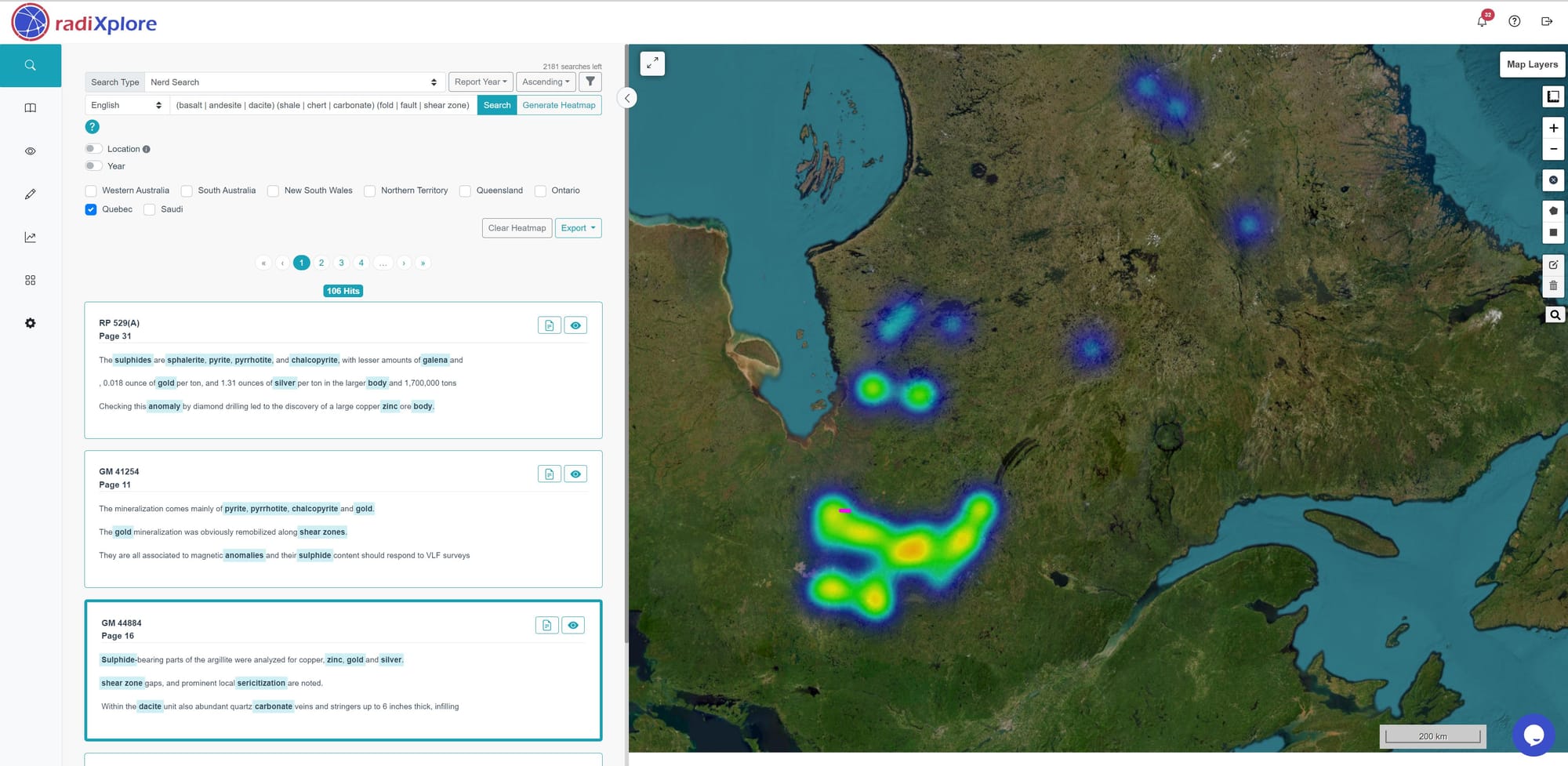Using RadiXplore's GeoAI to Hunt for VMS Copper in Quebec!
Explore how RadiXplore’s NerdSearch uncovers hidden Volcanogenic Massive Sulfide (VMS) deposits in Quebec's extensive SIGEOM archive. By analyzing millions of pages of historical data, we reveal potential new mineral resources buried in unstructured reports

In our previous post, 'Porphyry vs. VMS,' we explored why companies might favor Volcanogenic Massive Sulfide (VMS) copper deposits over Porphyry copper deposits, influenced by evolving economic, technological, and environmental factors. In this post, we'll delve into the process of identifying these VMS deposits by analyzing unstructured data repositories. These repositories hold the accumulated knowledge and experience of millions of explorers, documented in historical exploration and relinquishment reports, as well as scientific studies.
Searching for VMS Deposits in SIGEOM's Quebec Repository
Quebec's SIGEOM 'The Examine' repository houses over 80,000 reports, comprising more than 4.8 million pages, documenting the rich mining history of Quebec over the past 200 years. Within this vast collection lie 'treasure maps' to potential, yet unrecognized, mineral deposits, all concealed within these unstructured data formats. But how can we identify potential undiscovered VMS deposits within this repository? Ideally, if time were unlimited, a thorough review of all reports would allow us to pinpoint the key geological, mineralogical, and geochemical characteristics that indicate VMS deposits.
Let’s break down what a geologist would need to look for:
Geological Setting
Sedimentary rocks: Shale, chert, and carbonate rocks often accompany volcanic rocks in VMS settings and can provide clues about the depositional environment.
Structural features: Folds, faults, and shear zones can play a significant role in controlling the localization of VMS mineralization.
Mineralization
Precious metals: Gold and silver are often associated with VMS deposits, particularly in higher-grade zones.
Base metals: Zinc and lead are also common components of VMS mineralization.
Alteration
Spatial Relationships
Geochemical Signatures
The task of manually reviewing 4.8 million pages of handwritten, scanned reports in both English and French to identify a complex geological analogue is impractical and beyond human capability. Traditional keyword searches or even advanced language models like ChatGPT are insufficient to capture the nuanced context of this geological analogue. Fortunately, RadiXplore's innovative Hybrid Extractive Search Module, Nerd Search, is designed to tackle this challenge with ease.
The next step is to craft a precise Nerd Search query that effectively targets the desired information, enabling efficient extraction of relevant insights from the vast repository.
Constructing a Nerd Search Query
To effectively search for VMS deposits, we can focus on key geological, mineralogical, and geochemical characteristics:
- Geological Setting:
- Volcanic rocks: (basalt | andesite | dacite)
- Sedimentary rocks: (shale | chert | carbonate)
- Structural features: (fold | fault | shear zone)
- Mineralization:
- Sulfide minerals: (chalco* | sphalerite | galena | pyr*)
- Precious and base metals: (gold | silver | zinc | lead)
- Alteration:
- Hydrothermal alteration: (hydrothermal alteration | chlorit* | sericit* | siliceous)
- Spatial Relationships:
- Massive sulfide bodies: (lens | horizon | body | stockwork)
- Geochemical Signatures:
- Anomalies: Include “anomaly” or specific elemental anomalies.
Stitching all this together, we get
By using the query, NerdSearch pinpoints 106 potential results from the 4.8 million pages of reports. The geological settings can then be visualized geospatially through a heat map that highlights the document locations containing positive search results.

Let's analyze the selected report's text to determine if it could indicate a VMS deposit—

Based on the text from just this report, the geological setting and mineralization described suggest the possibility of a VMS deposit, but further information would be needed to confirm
Here are the key indicators supporting a VMS interpretation:
- Volcanic rocks: The presence of metavolcanics (andesite, rhyodacite, dacite) is consistent with VMS settings.
- Hydrothermal alteration: Sericitization and quartz-carbonate veining are common alteration features in VMS deposits.
- Sulfide mineralization: Pyrite and pyrrhotite are typical sulfide minerals found in VMS deposits.
- Structural disruption: The presence of shearing, brecciation, and cleavage suggests a structurally complex environment, which is often associated with VMS mineralization.
However, some aspects need further clarification:
- Gold mineralization: While gold is often found in VMS deposits, the low gold grades reported might indicate a different mineralization style or a less favorable portion of the deposit.
- Sedimentary rocks: The presence of argillites (metasedimentary rocks) could suggest a more distal setting for the mineralization, although VMS deposits can occur in sedimentary-dominated environments.
- Drill hole data: The lack of detailed information on sampled intervals and analytical results makes it difficult to assess the full extent and grade of the mineralization.
To strengthen the case for a VMS deposit, we would need to look for the following:
- Geochemical data: Detailed geochemical analyses for copper, zinc, lead, and other base metals.
- Structural analysis: A more comprehensive understanding of the structural setting and the relationship between the mineralization and faults or shear zones.
- Regional geological context: Information on other VMS deposits or volcanic centers in the area.
To confirm a VMS deposit, additional data such as detailed geochemical analysis and structural studies are essential. With RadiXplore, finding these answers is as straightforward as knowing what to search for and how to interpret the results.
Keep an eye out for future blog posts where we’ll explore whether this could indeed be a potential VMS deposit. Or get in touch with us at RadiXplore to start your own discovery journey!

